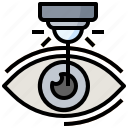
Understanding Your Insurance
Your physician’s office will provide us with your insurance and contact information prior to your arrival at our surgery center. An insurance specialist from our business office will verify with your insurance carrier and confirm that the appropriate authorization for surgery was received.
Depending on when we receive your insurance information, we will attempt to give you an estimate of charges or co-payment you are required to pay at registration. Cash, personal checks, and major credit cards will be accepted.
We accept most major insurance plans.
While we are contracted with most insurance carriers, PPOs, and Medicare, we always recommend giving your health insurance plan provider a call to confirm your coverage and benefits. The number can be found on your insurance card.
Eye Surgery Center of San Francisco is currently contracted with the following insurance providers:
- Aetna Health, Inc.
- Alignment Health Plan
- Anthem Blue Cross of California
- Bay Area Accountable Care Network (Canopy Health)
- Blue Shield of California
- Brown and Toland Health Services
- Care1st Health Plan
- Cigna Healthcare
- Health Net of California
- Health Net Federal Services
- Health Plan of San Mateo
- Imperial Health Holdings Medical Group
- Kaiser Foundation Hospitals
- MultiPlan, Inc.
- North East Medical Services
- On Lok Senior Health Services
- United Healthcare Insurance Company
- Universal Care, Inc. (Brand New Day)
The Cost of Your Outpatient Procedure
Patients are responsible for payment of their procedure.
Although we accept most major health insurance plans, every insurance plan is different. You may have options for where you have your outpatient procedure. You can use tools like Healthcare Bluebook and the Medicare Procedure Price Lookup (for Medicare patients) to find out your financial responsibilities to have a procedure performed at our facility. Many health insurance websites also provide information on where to find in-network services.
For an estimate of what your insurance will cover and what will be your responsibility, please contact your insurance carrier directly. If you do not have insurance or need payment arrangements, feel free to call us (415) 440-1100 for payment options.
Your Rights and Protections Against Surprise Medical Bills
When you get emergency care or are treated by an out-of-network provider at an in-network hospital or ambulatory surgical center, you are protected from balance billing. In these cases, you shouldn’t be charged more than your plan’s copayments, coinsurance and/or deductible.
What is “balance billing” (sometimes called “surprise billing”)?
When you see a doctor or other health care provider, you may owe certain out-of-pocket costs, like a copayment, coinsurance, or deductible. You may have additional costs or have to pay the entire bill if you see a provider or visit a health care facility that isn’t in your health plan’s network.
“Out-of-network” means providers and facilities that haven’t signed a contract with your health plan to provide services. Out-of-network providers may be allowed to bill you for the difference between what your plan pays and the full amount charged for a service. This is called “balance billing.” This amount is likely more than in-network costs for the same service and might not count toward your plan’s deductible or annual out-of-pocket limit.
“Surprise billing” is an unexpected balance bill. This can happen when you can’t control who is involved in your care—like when you have an emergency or when you schedule a visit at an in-network facility but are unexpectedly treated by an out-of-network provider. Surprise medical bills could cost thousands of dollars depending on the procedure or service.
You’re protected from balance billing for:
Emergency services
If you have an emergency medical condition and get emergency services from an out-of-network provider or facility, the most they can bill you is your plan’s in-network cost-sharing amount (such as copayments, coinsurance, and deductibles). You can’t be balance billed for these emergency services. This includes services you may get after you’re in stable condition, unless you give written consent and give up your protections not to be balanced billed for these post-stabilization services.
Certain services at an in-network hospital or ambulatory surgical center
When you get services from an in-network hospital or ambulatory surgical center, certain providers there may be out-of-network. In these cases, the most those providers can bill you is your plan’s in-network cost-sharing amount. This applies to emergency medicine, anesthesia,
pathology, radiology, laboratory, neonatology, assistant surgeon, hospitalist, or intensivist services. These providers can’t balance bill you and may not ask you to give up your protections not to be balance billed.
You’re NEVER required to give up your protections from balance billing. You also aren’t required to get out-of-network care. You can choose a provider or facility in your plan’s network.
If you get other types of services at these in-network facilities, out-of-network providers can’t balance bill you, unless you give written consent and give up your protections.
California: Comprehensive Balance Billing Protections
When balance billing isn’t allowed, you also have these protections:
If you think you’ve been wrongly billed, contact the No Surprises Helpdesk at (800) 985-3059.
Visit https://www.cms.gov/nosurprises for more information about your rights under federal law.
Visit https://www.commonwealthfund.org/publications/maps-and-interactives/2021/feb/state-balance-billing-protections for more information about your rights under California law
You Have the Right to Receive a “Good Faith Estimate”
Under the law, healthcare providers need to give patients who don’t have insurance or who are not using insurance an estimate of the bill for medical items and services.
You have the right to receive a Good Faith Estimate for the total expected cost of any non-emergency items or services. This includes related costs like medical tests, prescription drugs, equipment, and hospital fees.
Make sure your healthcare provider gives you a Good Faith Estimate in writing at least 1 business day before your medical service or item. You can also ask your health care provider, and any other provider you choose, for a Good Faith Estimate before you schedule an item or service.
If you receive a bill that is at least $400 more than your Good Faith Estimate, you can dispute the bill.
Make sure to save a copy or picture of your Good Faith Estimate.
For questions or more information about your right to a Good Faith Estimate, visit https://www.cms.gov/nosurprises or call (800) 985-3059.
How Billing for Anesthesia Works
Let’s begin with calling attention to the fact that Anesthesiologists and CRNAs are not always employed by the medical facility where a patient receives anesthesia care. A billing statement for anesthesia services may arrive separate from the our medical facility bill where a surgery or procedure takes place. The bill from an anesthesia provider is for the anesthesia services; developing the anesthesia plan, administering anesthesia and monitoring the patient’s vitals before, during and after a surgical procedure. It is possible to have a surgery or procedure at an in-network medical facility, but have an anesthesia provider that is not in-network with your insurance provider. Ask prior to any surgery or procedure if all your care providers are in-network.
Blue Eagle Anesthesia Group
(209) 956-7725
Patients that receive anesthesia care from Eye Surgery Center of San Francisco can expect to receive a billing statement in the mail for the anesthesia services received. The patient billing statement will reflect the payment options available. Those seeking financial assistance by means of a payment plan must contact Blue Eagle Anesthesia Group at the number provided on the patient billing statement to be put in touch with a billing specialist for other payment options.





